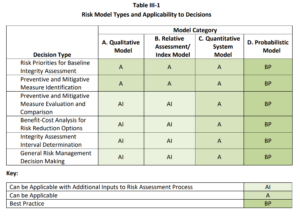August 31, 2024
Overview of Risk Model Categories in Pipeline Integrity Management

Pipeline integrity management is a critical component of ensuring the safety and reliability of pipelines that transport hazardous liquids and gas. Risk modeling plays a vital role in identifying potential threats and mitigating them effectively. This blog explores the various risk model categories used in integrity management systems and selecting the appropriate model, as outlined by the Pipeline and Hazardous Materials Safety Administration (PHMSA).
1. Qualitative Model
Qualitative models rely on both qualitative and quantitative inputs, producing qualitative outputs. These models are often used when data is limited or when the goal is to categorize risks into broader categories such as high, medium, or low. The algorithm in this model typically involves a direct mapping of inputs to outputs, often represented by a matrix.
For example, a pipeline segment might be categorized as “high risk” based on factors such as its age, location, and maintenance history. This categorization is often derived from expert judgment or historical data, translated into qualitative descriptors.
2. Relative Assessment/Index Model
Relative Assessment or Index models use a combination of qualitative and quantitative inputs to generate unit-less quantitative outputs. These outputs are typically derived using a scoring algorithm that assigns scores to different risk factors. The scores are then combined—often through summation, with or without weighting—to produce an index score.
The outputs of Relative Assessment models are not expressed in absolute units like probability or expected loss. Instead, they provide a comparative measure of risk. For example, an index score might indicate that one pipeline segment is at higher risk than another, but it doesn’t quantify the exact probability of failure.
3. Quantitative System Model
Quantitative System models are more advanced, using quantitative inputs to produce outputs in specific risk assessment units such as probability, frequency, or expected loss. This approach models the physical and logical relationships between different risk factors, providing a more direct reflection of reality.
For instance, the probability of a pipeline failure due to third-party excavation damage might be modeled by considering factors like excavation activity frequency, depth of cover, and the effectiveness of one-call systems. The model then combines these factors using logical relationships to calculate a failure probability in units like incidents per year.
4. Probabilistic Model
Probabilistic models are a specialized subset of Quantitative System models. These models incorporate uncertainty by using probability distributions for inputs, which are then propagated through the model to generate probability distributions for outputs. This approach is particularly useful for dealing with uncertainties in model inputs and providing a more comprehensive risk assessment.
For example, if the depth of cover for a pipeline is not precisely known, a probability distribution can represent the uncertainty in this input. The output, such as the probability of a pipeline failure, would then also be expressed as a distribution, providing a range of possible outcomes rather than a single deterministic value.
Moving Towards More Robust Models: Quantitative System and Probabilistic Models
As pipeline integrity management evolves, PHMSA recommends that operators consider adopting more robust risk modeling approaches, such as Quantitative System and Probabilistic models. These models are capable of supporting all risk reduction decisions and provide a more detailed and accurate representation of potential risks.
Operators should evaluate their current risk modeling practices and consider transitioning to these advanced models where appropriate. By leveraging the strengths of Quantitative System and Probabilistic models, operators can enhance their ability to identify, assess, and mitigate risks effectively, ultimately improving the safety and reliability of their pipeline systems.

Conclusion
Understanding these risk model categories supports a broader perspective on how to manage and mitigate risks effectively. Each model has its strengths and applications, from the more subjective qualitative models to the highly detailed probabilistic models. By selecting the appropriate model for their specific needs, operators can enhance the safety and reliability of their pipeline systems.
To learn more about how Cenozon’s Pipeline Integrity Risk Manager (PIRM) solution utilizes probabilistic models to deliver deeper insights and enhance decision-making in pipeline integrity management, click here.
References:
- PHMSA Risk Model Categories (Table II-1, February 2020)
- PHMSA Risk Model Categories (Table III-1, February 2020)
- ISO/IEC 31010:2009 – Risk Management – Risk Assessment Techniques
- Pipeline-Risk-Modeling-Technical-Information-Document-02-01-2020-Final_0.pdf (dot.gov)
